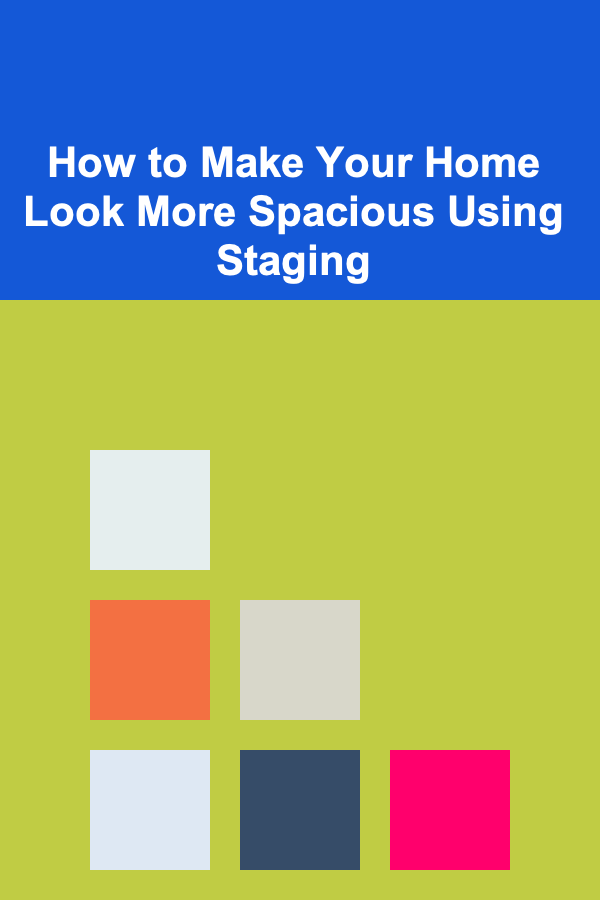
How to Make Your Home Look More Spacious Using Staging
ebook include PDF & Audio bundle (Micro Guide)
$12.99$8.99
Limited Time Offer! Order within the next:

Staging a home has become one of the most important strategies in real estate marketing, especially in a competitive market. The purpose of home staging is not only to make a property look more appealing but also to help potential buyers visualize the potential of a space. One of the primary goals of staging is to create the illusion of a larger, more open environment---especially in small homes or rooms. Home staging techniques can transform the feel of a property, making it appear more spacious and inviting.
This comprehensive guide explores the concept of home staging and how to use staging techniques to make your home appear larger. From furniture arrangement to lighting tricks, these strategies will help you optimize your space to make it look and feel more expansive.
The Importance of Home Staging
Home staging is the art of preparing a property for sale, highlighting its best features, and downplaying its less desirable aspects. The goal is to make the space as attractive as possible to potential buyers, allowing them to imagine themselves living in the home.
In the context of making a home feel larger, staging can be particularly important for smaller homes or rooms that lack natural light. Through clever design and the right staging techniques, you can enhance the perceived space, even if the actual square footage is limited.
Staging is a valuable tool for any homeowner or real estate agent looking to sell a property quickly and at the best price. It allows a home to stand out in a crowded market, presenting it in a way that speaks to the potential buyer's aspirations.
Understanding the Psychology of Space
Before diving into the practical aspects of home staging, it's important to understand the psychology behind space perception. Our perception of space is influenced by a variety of factors, including light, color, and layout. In the case of staging, these elements can be manipulated to make a room feel larger, more open, and more inviting.
Light
Light plays a crucial role in how we perceive space. A well-lit room often feels larger because light expands the visual boundaries of the room. By maximizing natural light and using artificial lighting strategically, you can create the illusion of more space.
Mirrors are one of the most effective staging tools for amplifying light. They reflect both natural and artificial light, creating a brighter environment that can help make a room feel more expansive.
Color
Color is another powerful tool in staging. Light, neutral colors like whites, grays, and beiges create a sense of openness and allow light to bounce around the room. In contrast, dark colors can absorb light and make a space feel more cramped. By choosing the right color palette, you can visually enlarge a room and create a sense of flow from one space to another.
Furniture Arrangement
The way furniture is arranged can significantly impact how spacious a room feels. Crowding a room with too much furniture can make it feel small and cluttered. On the other hand, arranging furniture thoughtfully and minimizing oversized pieces can help open up the room and create a more inviting atmosphere.
Tips for Staging to Make Your Home Look More Spacious
1. Maximize Natural Light
Natural light is one of the easiest ways to make a room feel bigger. The more light you can bring into a space, the more open and airy it will feel. Here are some ways to maximize natural light during the staging process:
- Use Light, Sheer Curtains: Heavy drapes can block out natural light, making a room feel smaller. Opt for light, airy curtains or blinds that allow as much light in as possible.
- Open Curtains and Blinds: Make sure curtains and blinds are open during showings to let the most light into the space.
- Clean Windows: Dust and grime on windows can block light. Ensure that your windows are clean to maximize natural light coming into the room.
- Strategic Mirror Placement: Mirrors reflect light and create the illusion of more space. Place mirrors opposite windows to bounce light around the room and enhance the feeling of spaciousness.
2. Use Light, Neutral Colors
Color has a profound impact on how a space is perceived. Light, neutral tones create the illusion of openness and can make even the smallest room feel larger. Here's how you can use color to your advantage:
- Paint Walls in Light Colors: Opt for whites, light grays, or soft beige tones for the walls. These colors make rooms feel more open and airy, especially when combined with plenty of light.
- Light Flooring: If you're considering replacing or updating the flooring, choose light-colored materials such as light hardwood, pale carpeting, or light tile. Dark floors can make a room feel heavy and closed off.
- Accent Colors: Use bold accent colors sparingly to add depth and contrast without overwhelming the space. Focus on using these accent colors in accessories like throw pillows, vases, and artwork.
3. Furniture Arrangement and Scale
When staging a home to make it look larger, the arrangement and scale of furniture play a crucial role. Too much furniture can make a room feel crowded, while properly scaled pieces help maintain a sense of space.
- Opt for Smaller, Scale-Appropriate Furniture: Choose furniture that is appropriately scaled for the room. In smaller spaces, avoid oversized couches or heavy furniture that can make the space feel cramped. Instead, opt for streamlined, smaller pieces that allow for more open floor space.
- Create Flow: Arrange furniture in a way that encourages easy movement through the room. Leave clear pathways and avoid blocking doors or windows with furniture. A well-organized layout can make a room feel more open.
- Avoid Clutter: Keep surfaces free of unnecessary items. Too many accessories or clutter can make a room feel smaller and more chaotic. Only display a few carefully selected pieces that complement the space.
4. Declutter and Depersonalize
Clutter is a major enemy of spaciousness. Excess items can make a room feel cluttered and smaller. The goal of staging is to create a clean, tidy, and welcoming environment. Here's how to declutter your space effectively:
- Remove Personal Items: Take down family photos and personal memorabilia. While these items may hold sentimental value, they can make the space feel cramped and prevent potential buyers from imagining themselves in the space.
- Streamline Surfaces: Clear off countertops, tables, and shelves. This will help to showcase the space and make the room feel larger and more organized.
- Use Storage Solutions: Invest in stylish storage solutions, such as baskets, bins, and hidden compartments, to keep everyday items out of sight. This will help maintain a clean and organized space.
5. Use Multi-Functional Furniture
In smaller homes or apartments, multi-functional furniture is an excellent choice for maximizing space. Furniture that can serve more than one purpose helps reduce clutter and optimizes the available square footage.
- Sofa Beds: For small living areas or guest rooms, a sofa bed can offer both seating and sleeping accommodations without taking up too much space.
- Storage Ottomans: Ottomans with built-in storage are a great way to add extra seating while providing a place to store items out of sight.
- Expandable Dining Tables: If you're staging a dining room, consider using a table that can expand for larger gatherings but can be kept compact for everyday use.
6. Create the Illusion of Height
In rooms with lower ceilings, creating the illusion of height can help the space feel more expansive. Here's how to achieve this:
- Vertical Lines: Use vertical stripes in wallpaper, paint, or textiles to create the illusion of height. This can make a room feel taller and more open.
- Hang Curtains High: Mount curtains close to the ceiling and let them drape all the way down to the floor. This will draw the eye upward and give the room a more vertical, spacious feel.
- Tall Furniture: Opt for taller, slimmer furniture instead of short and squat pieces. Tall bookshelves or narrow cabinets can give the illusion of more height.
7. Highlight Architectural Features
If your home has unique architectural features, such as high ceilings, exposed beams, or a fireplace, use staging to highlight these elements. By drawing attention to these features, you can make the room feel more expansive.
- Use Lighting to Highlight Features: Spotlights or accent lighting can draw attention to key architectural features, such as a fireplace or a statement wall.
- Arrange Furniture Around Focal Points: Position furniture so that it frames architectural elements. For example, place seating around a fireplace to highlight its presence in the room.
8. Add Mirrors Strategically
Mirrors are an incredibly effective tool for creating the illusion of space. They reflect light, make the room feel more open, and can even help visually expand the size of the room.
- Large Mirrors: A large mirror on one wall can make a room feel much larger by reflecting the entire space and amplifying the available light.
- Multiple Mirrors: Strategically place smaller mirrors throughout the space to enhance depth and reflect light from various angles.
9. Use Rugs to Define Spaces
In open-concept homes, rugs can help define individual areas within a room without making the space feel more cramped. A well-placed rug can create a sense of division between different functions in a room while maintaining the flow of the overall space.
- Choose Light Rugs: Stick to light-colored rugs that won't overwhelm the room. They can help make a space feel open while adding texture and warmth.
- Use Rugs to Create Zones: In a large, open room, use rugs to create distinct zones, such as a seating area and a dining area, without physically partitioning the space with walls.
10. Keep It Fresh and Neutral
When staging a home, it's important to keep the design neutral and fresh. Neutral colors, clean lines, and minimal accessories allow potential buyers to imagine themselves in the space, without being distracted by bold design choices or personal taste.
- Simple and Clean Lines: Stick to simple furniture with clean lines. Avoid overly ornate or heavy pieces that can overwhelm the space.
- Fresh Flowers or Greenery: A touch of fresh flowers or greenery can add life to a room without cluttering it. Choose plants that complement the neutral color palette of the room.
Conclusion
Home staging is a powerful tool for making a space feel larger and more inviting. By maximizing natural light, using light colors, and arranging furniture thoughtfully, you can create the illusion of a more expansive space. Decluttering, using multi-functional furniture, and highlighting architectural features are also essential techniques for optimizing space in a home.
Whether you are preparing your home for sale or simply looking to refresh your living environment, staging can transform the look and feel of a room. By applying these strategies, you can create a spacious and welcoming atmosphere that appeals to potential buyers and enhances the overall ambiance of your home.
Reading More From Our Other Websites
- [Personal Care Tips 101] How to Exfoliate to Prevent Ingrown Hairs
- [Home Security 101] How to Keep Your Garage Secure: Tips and Tricks
- [Organization Tip 101] How to Keep Your Recipe Books Neat and Damage-Free
- [Skydiving Tip 101] Understanding Weather Risks: Making Informed Decisions Before You Jump
- [Personal Financial Planning 101] How to Invest Wisely: A Beginner's Guide to Smart Investing
- [Personal Investment 101] How to Monetize Your Deep Learning Skills for Ongoing Income
- [Home Budget Decorating 101] How to Find Budget-Friendly Storage Solutions for Your Home
- [Organization Tip 101] How to Create a Digital Vision Board to Stay Motivated
- [Organization Tip 101] How to Use Shelving Solutions for Small Antique Objects
- [Organization Tip 101] How to Use Binders for Organized Note Taking and Storage

How to Communicate Effectively with Tenants
Read More
How to Plan a Themed Party That Everyone Will Enjoy
Read More
How to Profit from Deep Learning by Building Custom Models
Read More
The Ultimate Guide to Comparing Internet Service Providers for Better Deals
Read More
How to Use Credit Responsibly
Read More
10 Tips for Designing Unique Puppet Characters
Read MoreOther Products

How to Communicate Effectively with Tenants
Read More
How to Plan a Themed Party That Everyone Will Enjoy
Read More
How to Profit from Deep Learning by Building Custom Models
Read More
The Ultimate Guide to Comparing Internet Service Providers for Better Deals
Read More
How to Use Credit Responsibly
Read More